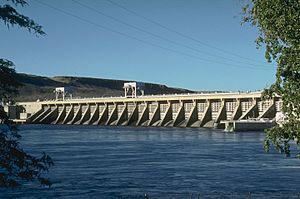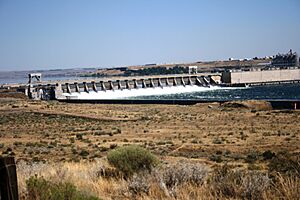McNary Dam facts for kids
Quick facts for kids McNary Dam |
|
|---|---|

Spillway view from the southwest, Oregon side of the Columbia River
|
|
| Location | Benton County, Washington / Umatilla County, Oregon, USA |
| Coordinates | 45°55′47″N 119°17′46″W / 45.92972°N 119.29611°W |
| Construction began | 1947 |
| Opening date | 1954 |
| Operator(s) | U.S. Army Corps of Engineers (Operator) |
| Dam and spillways | |
| Type of dam | Concrete gravity, run-of-the-river |
| Impounds | Columbia River |
| Height | 183 feet (56 m) |
| Length | 7,365 feet (2,245 m) |
| Spillway type | Service, gate-controlled |
| Reservoir | |
| Creates | Lake Wallula |
| Total capacity | 1,350,000 acre⋅ft (1.67 km3) |
| Power station | |
| Commission date | 1954-1957 |
| Turbines | 14 |
| Installed capacity | 1,127 MW |
| Annual generation | 5,170 GWh |
The McNary Dam is a huge concrete dam that stretches 1.4 miles (2.2 km) across the Columbia River. It connects Umatilla County, Oregon and Benton County, Washington. This dam is about 292 miles (470 km) from where the Columbia River meets the ocean.
It's a "run-of-the-river" dam, which means it uses the natural flow of the river to make electricity. It doesn't store a lot of water in a huge reservoir like some other dams. The U.S. Army Corps of Engineers operates the dam. This is a government group that builds and manages many important water projects.
The dam is located near the town of Umatilla, Oregon. It was first going to be called the Umatilla Dam. But in 1945, it was renamed to honor Charles L. McNary. He was a Senator from Oregon who had passed away.
Contents
What Does McNary Dam Do?
McNary Dam helps with many things. It makes the river calm for boats to travel easily. It also creates electricity, offers places for fun activities, and protects homes for wildlife. Sometimes, it even helps with watering farms.
Building the Dam: A Big Project
Ideas for building a dam here started way back in 1931. In 1941, the U.S. House of Representatives approved the project. The main reasons for building it were to help boats travel, make electricity, and for national security.
Construction of the dam began in 1947. It took seven years to build, and the dam was finished in 1954. All the machines that make electricity were working by 1957. The dam can produce 980 megawatts of power.
How Fish and Boats Pass the Dam
The dam has two special "fish ladders." These are like staircases for fish, helping salmon and steelhead swim past the dam. One ladder is on each side of the river.
On the Washington side, there's also a large navigation lock. This is like an elevator for boats! It's 86 feet (26 m) wide and 683 feet (208 m) long. It lifts boats an average of 75 feet (23 m) so they can continue their journey up or down the river.
Lake Wallula: The Dam's Reservoir
When the dam was built, it flooded an area called the Umatilla Rapids. This created a large reservoir called Lake Wallula. This lake stretches for 64 miles (103 km) up the Columbia River. It also extends up the Snake River to the Ice Harbor Dam.
How McNary Dam Powers Itself
McNary Dam is special because it can power itself! It has two extra turbines, which are like giant spinning engines. These turbines are only for the dam's own needs. They make sure the dam always has the electricity it needs to run.
These two "station service" turbines are much smaller. They make about 3 megawatts of power each. The other 14 main turbines each make 70 megawatts! The two smaller turbines take turns providing power to the dam.
If there's a big power outage in the area, McNary Dam can even help restart other power plants. This is called "black start" capability.
McNary Dam's Key Facts
- Altitude: 344 feet (105 m) above sea level
- Height: 183 feet (56 m)
- Length: 7,365 feet (2,245 m)
- It's a single-lift lock, meaning it lifts boats in one go.
- It is 86 feet (26 m) wide.
- It is 683 feet (208 m) long.
Powerhouse Details
- It has 14 large units, each making 70,000 kilowatts of power.
- The total power it can make is 980 megawatts.
- It can even produce up to 1,127 megawatts if needed!
Spillway Details
- The spillway has 22 gates.
- It is 1,310 feet (399 m) long.


